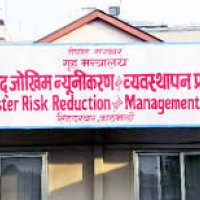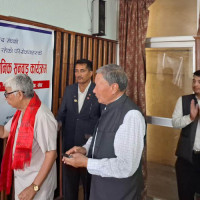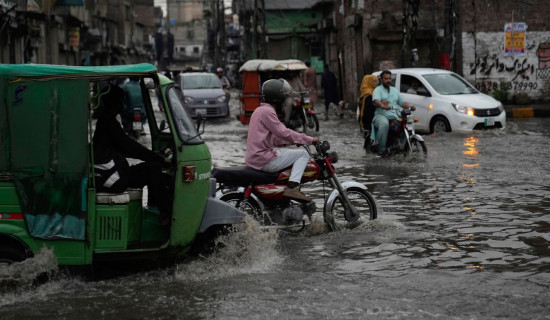- Tuesday, 1 July 2025
Solar Thermal Fuels Greener Future
As Nepal deepens its commitment to achieving net-zero emissions by 2045, one critical sector of our energy system remains noticeably underdeveloped: heating, cooking, and cooling. Accounting for nearly 50 per cent of Nepal’s final energy demand, this sector relies heavily on firewood, coal, LPG, and imported oil — polluting, expensive, and increasingly unsustainable fuels. Petroleum products alone contribute 26 per cent of Nepal’s total energy supply, draining foreign exchange reserves and exacerbating air pollution. If we are serious about our climate goals, transforming this sector must become an urgent national priority.
While Nepal has made commendable progress in hydropower and solar PV, we have largely overlooked a proven, cost-effective solution for our biggest energy challenge: solar thermal. Despite its five-decade track record, solar thermal has not received comparable investment and political attention. While solar PV converts sunlight into electricity, solar thermal technology directly harnesses the sun's heat, offering an efficient solution for water heating, space heating, and industrial applications.
Stark gap
Globally, countries such as Austria, China, Germany, and India have successfully adopted solar thermal at scale. Nepal, however, despite having one of South Asia’s highest solar radiation levels (1,600–2,000 kWh/m² annually), has underutilised this resource. As of 2022, the country had only 300,000 m² of installed solar thermal collector area, placing it 41st worldwide in total capacity. With a per capita installation of just 0.01 m² — far below the 0.5–0.9 m² seen in nations like Austria and Barbados — the gap is stark. Nevertheless, progress is being made: between 2020 and 2023, Nepal added an estimated 20,000–27,000 solar water heaters (SWHs) annually, signalling stable growth but insufficient growth.
Solar thermal systems have diverse uses, including heating domestic hot water, heating buildings, and providing process heat for industrial purposes, large-scale cooking and drying crops. Additionally, solar thermal energy can provide cooling for air conditioning in buildings or preserve perishable goods. The size of these systems ranges from very small systems designed for heating water in single-family homes to systems in the gigawatt range for industrial process heat.
In Nepal, these same sectors — heating domestic hot water, space heating, and industries/agriculture — have the greatest potential for using solar thermal energy. In addition to water heating, solar heat for industrial processes (SHIP) has gained global interest. The total global number of SHIP plants is approximately 1,200 systems, with 1.4 million square metres of collector area and a capacity of 951 MWth. Globally, these systems are primarily plants in the mining, food, and beverage industries.
Solar thermal plants used in industries could significantly reduce the import of fossil fuels. This is particularly important as 43 per cent of Nepal’s total final energy consumption in the industrial sector is currently derived from oil and coal. Recognising this untapped potential, the Alternative Energy Promotion Centre (AEPC) and the International Centre for Integrated Mountain Development (ICIMOD) have prepared a comprehensive Solar Thermal Roadmap and Implementation Plan.
This initiative charts a strategic course for the widespread adoption of solar thermal technologies, aligning with Nepal’s long-term goals for energy security, economic prosperity, and environmental sustainability. The roadmap’s primary objective is to accelerate solar thermal deployment across residential, commercial, and industrial sectors. By setting clear targets and actionable steps, it aims to enhance energy efficiency, reduce greenhouse gas emissions, and improve energy access, critical pillars of Nepal’s climate resilience and sustainable development.
The roadmap’s influence is already visible. For the first time, Nepal’s climate action plans, NDC 3.0, unveiled by the Prime Minister at the Sagarmatha Sambad, include explicit solar thermal targets: by 2035, household solar thermal installations will be expanded to 1,354 MW-thermal for hot water and space heating (up from the current 389 MWth). Industrial solar thermal installations will be increased to 29 MWth (from the current 1.2 MWth).
This marks a turning point for solar thermal, now officially recognised as a priority sector. Yet challenges remain — barriers in standards, taxes, technical capacity, and public awareness. The bases for the development of solar thermal in Nepal have already been laid: the technology is proven, the roadmap is ready, and NDC 3.0 has set clear targets. Now, success hinges on political will, private sector engagement, and public support to accelerate adoption.
Energy consumption
Small-scale solar water heating systems and solar combi-systems (which combine hot water preparation and space heating for single-family houses, apartment buildings, hotels and public buildings) account for about 60 per cent of the world’s annual installations. In Nepal, solar thermal plants used in industries could significantly reduce the import of fossil fuels. This is particularly important as 43 per cent of Nepal’s total final energy consumption in the industrial sector is currently derived from oil and coal.
A growing sector utilising solar thermal systems is horticulture and solar drying. These systems are increasingly being used to heat greenhouses for flower and vegetable cultivation and in facilities for drying agricultural products such as tea, fruits, and grains. With visionary leadership, collaborative action, and public support, we can make this overlooked technology a cornerstone of our clean energy future. Let us not miss this opportunity. Let the sun do what it has done for millennia — warmth. This time, let’s harness it wisely.
(Ghimire is a Director at AEPC and Malla an energy specialist/intervention manager at ICIMOD.)

















